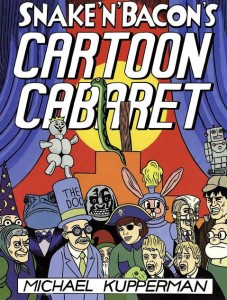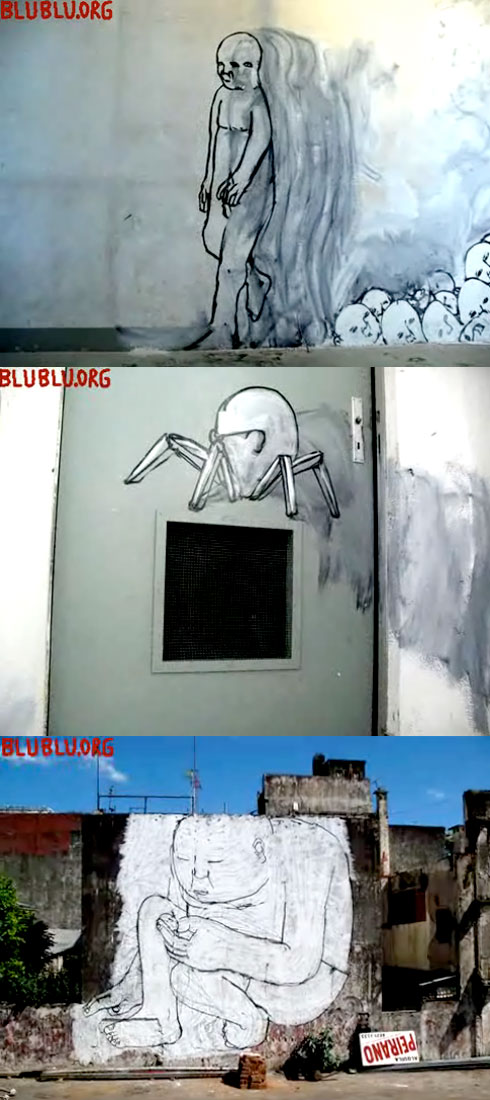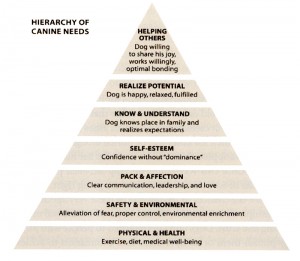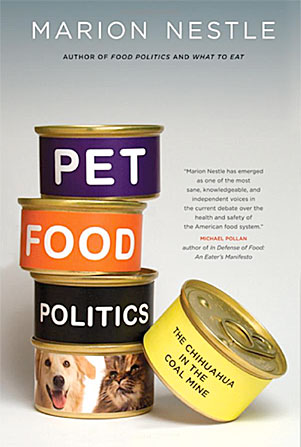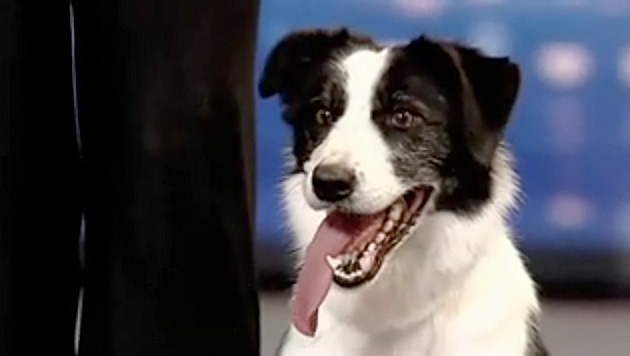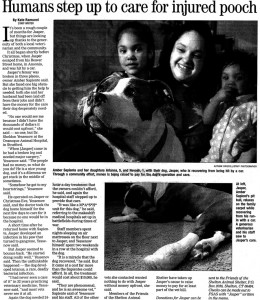Satre Stuelke’s CT Scan Art
March 24, 2009
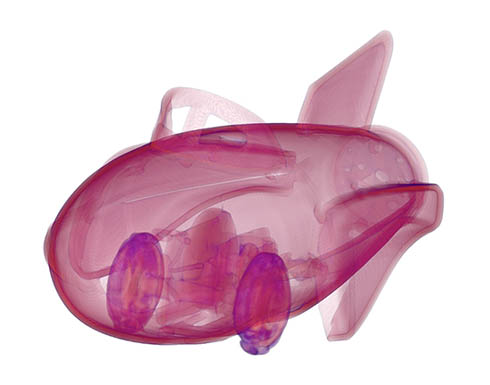 CT scans or CAT scans, more precisely computed axial tomography scans, are not generally considered art. But when Satre Stuelke’s CT scans of common objects like his children’s toys or a serving of Chicken McNuggets are the subject, they certainly look like art. It’s a case of the familiar seen in a compelling new way.
CT scans or CAT scans, more precisely computed axial tomography scans, are not generally considered art. But when Satre Stuelke’s CT scans of common objects like his children’s toys or a serving of Chicken McNuggets are the subject, they certainly look like art. It’s a case of the familiar seen in a compelling new way.
(Listen, if Damien Hirst is an artist—selling sharks, sheep and cows preserved in formaldehyde* at record setting prices—than Satre Stuelke more than qualifies in my view).
In addition to his still images, he’s also made videos that rotate his subjects through space and make them come weirdly alive.
Go here for the New York Times article on his work, or visit his site, Radiology Art for more images and video.
______________________________________________________
*OT: In Rudolph Grey’s 1994 oral biography Nightmare of Ecstasy: The Life and Art of Edward D. Wood, Jr. it is claimed that Bela Lugosi, addicted to morphine and methadone due to chronic sciatica pain, took to drinking formaldehyde in his final days. This, along with habit of smoking cheap, Italian cigars (referred to as Dago ropes) led to the common complaint of his associates that Lugosi always ‘stunk.’ At least the dissipated actor didn’t call it ‘performance art’.
Add Crispy Bacon to any Web site — The New ‘Must Have’ Web App
March 24, 2009
 Of course, you and I have longed to be able to add thick, crispy bacon to our web sites and those of our frenemies for years now, ever since we first uploaded that flashing GIF animation that told the world our site was “UNDER CONSTRUCTION.”
Of course, you and I have longed to be able to add thick, crispy bacon to our web sites and those of our frenemies for years now, ever since we first uploaded that flashing GIF animation that told the world our site was “UNDER CONSTRUCTION.”
And now you can! By the good graces of those fine folks at Bacolicio.us.
While we’re on the subject of wonderful, crisp, delicious bacon we have to give a shout out to Michael Kupperman’s fantastic creations, Snake ‘n’ Bacon. If you haven’t read any of Kupperman’s work, do it now! before it’s too late. You’ll thank me later. . .
The Evolution of Color Vision from Scientific American
March 24, 2009
Scientific American has an outstanding, in-depth article about the evolution of color vision from the dichromatic (two color) vision of other mammals (dogs, for example) and the trichromatic vision that gives us the ability to see the full color spectrum. I think it makes for fascinating and rewarding reading.
To our eyes, the world is arrayed in a seemingly infinite splendor of hues, from the sunny orange of a marigold flower to the gunmetal gray of an automobile chassis, from the buoyant blue of a midwinter sky to the sparkling green of an emerald. It is remarkable, then, that for most human beings any color can be reproduced by mixing together just three fixed wavelengths of light at certain intensities. This property of human vision, called trichromacy, arises because the retina the layer of nerve cells in the eye that captures light and transmits visual information to the brain uses only three types of light-absorbing pigments for color vision. One consequence of trichromacy is that computer and television displays can mix red, green and blue pixels to generate what we perceive as a full spectrum of color.
101 High Quality CSS And XHTML Free Templates And Layouts from 1stwebdesigner
March 24, 2009
1stwebdesigner has put together a selection of high-quality, professional XHTML and CSS templates that are free to use (check the licenses that come with each for specific instructions and restrictions). You can learn a great deal from checking out the coding on these, as well as using these layouts for inspiration for your own designs.
Wall-Painted Graffiti Animation “Muto” by Blu
March 18, 2009
An artist who goes by the single name Blu has created an astounding wall-painted graffiti stop-motion animation tiled Muto. It was created in Buenos Aires, Argentina and Baden, Switzerland with music by Andrea Martignoni and produced by Mercurio Film.
A series of transformations that travel across walls, sidewalks and building interiors involving human figures, alien-like blobs, insects, skeletons and frankly unclassifiable creatures, it is well worth checking out.
I’ve never seen anything like it done this particular way. An immense amount of labor obviously went into this unique project. Screen captures below.
Best, Short Dog Book Ever – Nicholas Dodman’s “The Well-Adjusted Dog”
March 17, 2009
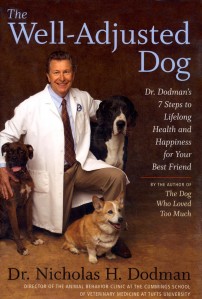 Dr. Nicholas Dodman, Director of the Animal Behavior Clinic at the Cumming School of Veterinary Medicine at Tufts University has produced a small gem of a book, The Well-Adjusted Dog.
Dr. Nicholas Dodman, Director of the Animal Behavior Clinic at the Cumming School of Veterinary Medicine at Tufts University has produced a small gem of a book, The Well-Adjusted Dog.
There’s more good, solid information in its 250 pages than in a whole host of other books written by dog ‘experts’ who have little or no credentials in the science and study of canines (Cesar Milan, I’m looking at you).
“Your job as a dog owner,” Dodman writes “is to try and understand your dog’s life fro his point of view, and to lead and protect, not to dominate, punish, and force a dog into submission, as popularized on too many of today’s TV shows.”
When this book comes out in paperback, I can see giving out multiple copies to neighbors and fellow dog owners, rather than trying to answer their questions myself.
One of the first and most vital points he makes is his belief that most dogs are under-exercised and bored out of their minds. (From my own experience I think this analysis is on the money). This leads to a multitude of behavioral problems including barking, inappropriate chewing, aggression, tail chasing, licking to the point of skin damage and more.
The average dog needs a minimum 30 minutes of aerobic exercise a day, every day. How many dogs do you know that meet that requirement?
Given that behavioral problems are the primary reason dogs are surrendered to shelters (the majority of whom are fated for euthanasia/destruction) proper handling of these issues may be essential to save the life of someone’s pet.
What I especially appreciate is his easy prose style and the clarity of his thinking even in controversial areas like herbal treatments and nutraceuticals. Here’s a sample of his writing about alternative medicine for dogs:
“Homeopathy—wherefore art thou, homeopathy? Though it’s popular in Europe, I have serious concerns about this branch of alternative medicine. The theory, of course, is that a little does of what ails you does you good. I can see how the concept applies to vaccination and desensitization to allergens, because inoculates stimulate an immune response—but I can’t see how it applies in other situations. Various homeopathic behavioral remedies containing microscopic concentrations of herbal products are now on the market.”
“One such remedy — anti-anxiety drops— was originally developed by an Irish veterinary practitioner who whipped up a dilute concoction of herbs to treat mastitis (inflammation of the udder) in cows. Being a large-animal vet, cows and mastitis were dear to his heart. In a moment of brilliance, he decided to bottle the cattle remedy for use in dogs to treat what else but . . .anxiety. And thus anti-anxiety drops were created. Whether the product actually works is doubtful, but bottles of the stuff are flying off the shelves. Naturopaths are positively swarming for it. Testing of this product presumably went like this:
- Take a worried-looking, baking dog and film him.
- Put the anxiety drops on his tongue.
- Wait until he has calmed down.
- Film him again.
- He’s calm.
- It’s a miracle!
The point they seemed to miss is that the only mental state that can follow a disturbed one is calm. It’s just a matter of time. I sent a sample of the anti-anxiety drops to the Department of Biochemistry and Experimental Therapeutics at Tufts medical school to see whether I ws missing something about the ingredients. The reply came back, ‘Nick, there’s virtually nothing here. It’s water.’ I guess that’s the point.”
Dodman also has constructed a pyramid Hierarchy of Canine Needs (adapted from psychologist Abraham Maslow’s triangle of human needs) that neatly summarizes what you as a caring dog owner should be striving towards. See how close you are coming to these goals with your own dog. Click image for larger size.
The bottom line: Buy This Book!
More Peanut Corp. of America recalls: 3 Flavors of Alaska Canine Cookies
March 13, 2009
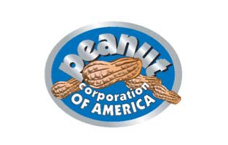 The peanut butter, “power-bone” and carrot cake flavors of Alaska Canine Cookies are among the latest dog treats being recalled due to possible Salmonella Typhimurium contamination. Source.
The peanut butter, “power-bone” and carrot cake flavors of Alaska Canine Cookies are among the latest dog treats being recalled due to possible Salmonella Typhimurium contamination. Source.
They were all manufactured with re-called batches of peanuts processed at the Blakely, Georgia processing facility of the now bankrupt Peanut Corporation of America. This plant, operating since 2005 had never been licensed and was never inspected. Yet is was contributing to America’s food supply.
It is alleged that PCA plant managers shipped peanuts that tested positive for salmonella a dozen times in 2007 and 2008. Inspectors also found unsanitary conditions: mold, roaches, a leaking roof, dead rodents, rodent excrement, and bird feathers in a crawl space above a production area. And it was contributing to America’s food supply. Source.
In Bankcruptcy court in Lynchburg, VA owner Stewart Parnell and family members put on a dumb show. He plead the Fifth, his right not to give self-incriminating evidence, when asked if he knowingly shipped salmonella-tainted peanut products from his plants in Blakely, Georgia and Plainview, Texas.
He answered, “I don’t know” to routine business questions and left most of the talking to his daughter, Grey Adams, the firm’s bookkeeper, claiming that “she knows more than I do” about the plant’s operation.
On the stand Ms. Adams was unable to tell the court the salary her mother was paid as office manager. When asked if the company paid dividends to its stockholder from their $20 million in sales in 2008, she replied, “What’s a dividend?” Source. Does it seem like the extended Parnell family suddenly came down with a severe case of the Stupids?
The numbers: Since Jan. 12th 2009, 3,420 products containing peanut ingredients processed by Peanut Corporation of America have been recalled. They include snacks, peanut butter, brownies, cakes, pies, ice cream, candy, cereal, cookies, crackers, donuts, and pet food and treats. 683 people in 46 states have been sickened, a quarter of them requiring hospitalization and 9 have died — although these deaths have not yet been linked definitively to the salmonella outbreak. Source.
Another number: Total cost of this outbreak? In excess of $1 billion, said Don Koehler, executive director of the Georgia Peanut Commission while speaking before a House small business subcommittee. Source.
The big question: how are we going to secure the safety of the American food supply chain in the 21st century?
.
Pet Food – Nutrition & Contamination: Educate Yourself
March 11, 2009
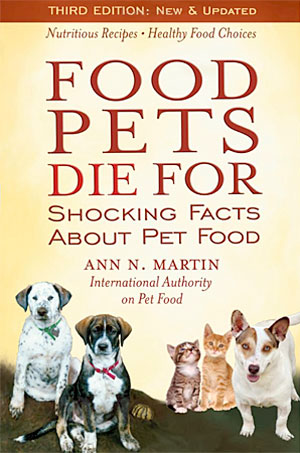 Want to understand the issues surrounding pet food nutrition and contamination? Read these two books.
Want to understand the issues surrounding pet food nutrition and contamination? Read these two books.
Ann Martin and Marion Nestle have done the research and pulled together the facts to make their books essential reading for everyone who cares about what they feed their dog or cat.
Martin’s book gives you the sordid truth behind the ingredients in many pet foods while Nestle recounts in great detail the Menu Foods recall and settlement of 2007, dealing with the failure of regulatory oversight.
In the current economy paying more for dog food is, I realize, a hard sell but when you consider the true cost (including veterinary bills) of the cheapest brands you might be willing to cut back elsewhere on your budget.
Outstanding Canine Freestyle Dance Routine — Gin, the Border Collie
March 11, 2009
OK, I’m not certain I can consider Canine Freestyle Dancing a true art form — it’s more like a throwback to the days of Vaudeville — but you’ve simply got to watch this clip from “Britain’s Got Talent” featuring 16 year-old Kate and her 6 year-old border collie, Gin.
I apologize in advance for the fact that you’ll be forced to bear a few moments of that demon Satan-spawn Simon Cowell — you can take a long, hot shower afterward. Click on photo for a larger image.
Please Donate to help Jasper, a Pit Bull struck by a Car, then hit with Gangrene and Tetanus
March 7, 2009
If, in these dismal economic times, you can spare any funds at all, please consider this canine appeal. The complete story is on the left.
<Click image for larger view. Connecticut Post, 3/05/09
Donations should be sent to the Friends of the Shelton Animal Shelter, P.O. Box 2036, Shelton, CT 06484. Checks can be made out to FSAS with “Jasper” written in the memo line.
Most vets are nice enough people, competent and caring. But Sheldon Yessenow is a cut above the rest. I can say this because I got to know him during the 5 years I spent volunteering with a Labrador breed rescue group, Labs4Rescue “Save a Lab, have a friend for life.” What he and his staff have done for Jasper, the pit bull is what they’ve always done — go above and beyond.
Dr. Sheldon Yessenow, DVM runs the Oronoque Animal Hospital in Stratford, CT. In practice for over 30 years, he’s a recipient of the Connecticut Veterinary Medical Association’s Best Vet of the Year Award. When Hurricane Katrina ht the Louisiana coast in August of 2005, he left his practice for 6 weeks to help treat the thousands of lost and abandoned dogs and cats the storm left in its wake. Here’s a little more about him in his own words from a New York Times profile:
“I was always interested in animals. I remember coming home on the school bus one day and noticing an injured squirrel on the side of the road. I hooked a wagon to the back of my bike and rode over to where I had seen the squirrel. Although I found a mother squirrel dead, one of the babies was still alive so I picked it up, brought it home, put it in an incubator, nursed it back to health until it bit me, and I let it go.“
“We deal with a lot of emotional, psychological and personal issues outside of the pets’ physical problems. There are people who come to us with hopelessly ill pets who want to do everything they can to help, regardless of the cost. On the other hand, you might be involved with people whose pets have very treatable conditions and who don’t want to spend any time or money whatsoever. It’s hard to know.”
“I wanted to work on animals, not people. In human medicine, you need to specialize, but in veterinary medicine you could be a generalist and do obstetrics, dermatology, dentistry, neurology, internal medicine. I do everything from orthopedic surgery to trimming toenails. One time, this dog went into the woods to tangle with a porcupine. With the pet under anesthesia, it took me an hour and half to take out all the quills.” — from “My Job; I See Your Pets as Your Children,” The New York Times. Feb. 7, 2001

